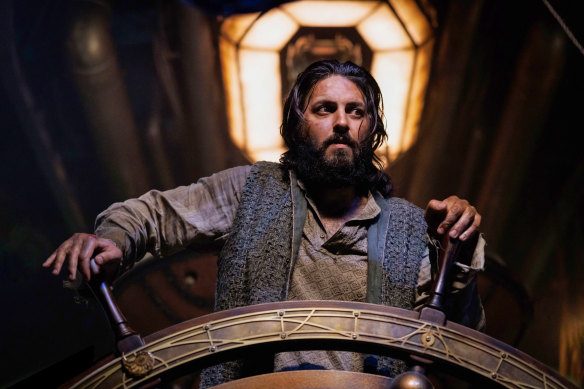
The series was filmed in Queensland from February to December 2022, employing at its peak 550 cast and crew and occupying three sound stages at Village Roadshow Studios.
“I would say 80 per cent of the people employed were Queenslanders, most of the cast was Australian,” says Marchand. “The great thing about Queensland is it gives you so many worlds. The show takes you from India and journeys across the oceans of the world up through the frozen Arctic and down into England. Each episode is a different universe.”

Verne originally wanted his Nemo to be Polish, but in the 1874 sequel he cast him as an Indian prince at war with British colonialism.Credit: Stan
Though the overall budget was massive, Marchand insists “the cost per minute we did very, very well, because it was like making 10 little mini-movies, all with an entirely new world. The money is on the screen.”
Naturally, much of the story is set aboard the Nautilus, the submarine aboard which Nemo and his crew sail the seas, encountering giant aquatic creatures and running afoul of navies and pirates. But that’s where this story and the Nemo of the earlier film version part ways.
Nemo first appeared in 1869, in fortnightly instalments published in a French magazine and issued in novel form the following year. Though Frenchman Verne had originally considered his hero to be Polish, his publisher convinced him to leave his hero’s origins murky.
But in the follow-up novel Mysterious Island (1874), Verne had Nemo deliver a deathbed confession in which he revealed he was in fact an Indian prince named Dakkar, who bore a hatred of British imperialism and led an uprising against colonial rule in Sepoy (a reference to the real-life Indian rebellion of 1857).
“He was wounded 10 times in 20 battles,” Verne wrote, “and was unable to find death when the last soldiers of independence fell before the English guns.”
This is the Nemo of Nautilus, a high-born Indian anti-colonialist adventurer, played by Shazad Latif.
The seed of the idea came from writer Mark Stay, whose pitch Marchand optioned in 2020, but it was writer James Dormer – a former British diplomat who had been based in Delhi, whose mother was born in Hyderabad, and whose kids are half-Bengali – who brought it to life.
It is, he says, an anti-colonial tale with sea monsters. But it was important to ensure his “bad guys” always remained human.
“The thing was always to keep hold of both sides of the story, so that it’s balanced, so you’re not just hitting people over the head with the message,” says Dormer. “People are complicated, and what we’ve tried to do with all the characters, even the bad guys, is give them a reason for doing what they’re doing, so you understand them.”
*NOTE: While the many screen adaptations have used the title 20,000 Leagues Under the Sea, Verne’s novel was originally published as Vingt Mille Lieues sous les mers (Twenty Thousand Leagues Under the Seas, plural).









 Add Category
Add Category